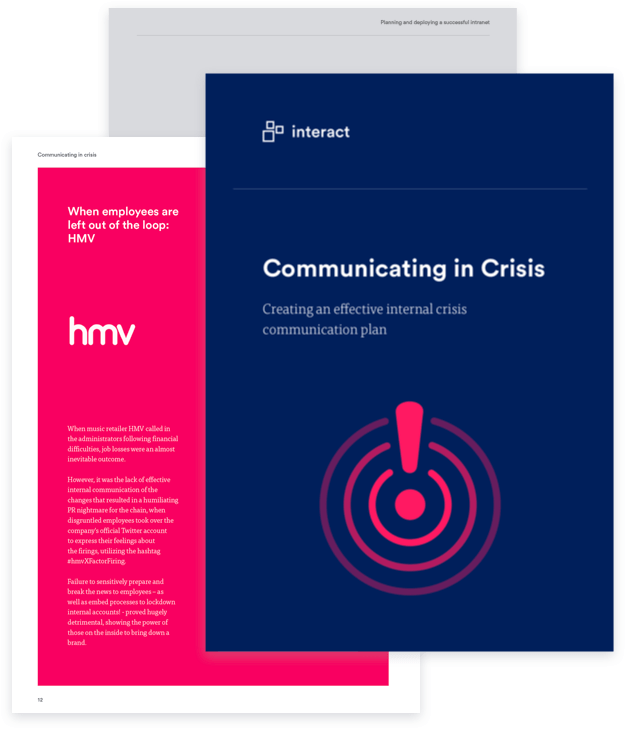…And why it’s best to not wait for a crisis to find out whether you’re prepared for one.
Most internal comms professionals are well aware that not every employee reads every single message sent out. And in the modern workplace, that’s understandable. Emails, meetings, Slack alerts, Microsoft Team alerts, mobile notifications… there’s a lot of noise out there. Getting an essential message to the right people is just one of the biggest challenges of an internal comms team.
That’s why we need to ensure that we implement a few procedures to make our comms more effective. One of these is creating a crisis communications strategy that involves every worker, regardless of where they are. After all, when a significant event happens that risks the safety of our employees, it is of the utmost importance that we contact every single one of them and deliver the information that they need.
So how do you cut through the usual workplace noise to land targeted communications right to your people?
Best practice for urgent emergency comms

Of course, the best insurance is making sure you have an effective crisis comms strategy before an event occurs. This is a priority for every business, as part of their duty of care. An effective plan rests on the internal communications department, ensuring they take particular measures when sending out their messages:
Urgency is key: When sending out crisis comms, timeliness is crucial. Therefore, you must be able to trigger a message that is sent to mobiles and desktops within moments of your department receiving information.
Full coverage: The key to effective crisis communication is the regular updating of staff throughout the whole situation. This means communicating before, during, and after. By doing this, you keep employees informed, and you help to minimize rumor and gossip.
Preparation: many organizations find that having preconfigured emergency messages on file gives them peace of mind if the situation arises. This way, there is no panic over who creates what, and messages can be altered to suit the exact scenario.
Creating an effective internal crisis comms plan
Be specific: In moments of crisis, it goes without saying that there is no room for extraneous detail. Make sure your message is direct and straight to the point and contains all the information that your audience needs to stay safe.
Target your audience: There’s clearly no need to tell all US-based colleagues that there has been a power failure in a UK office. Make sure your message goes to the relevant people. It also pays to have a general news announcement to keep everyone up to date.
A solution to crisis comms panic

Trying to compose anything amid a volatile situation is complicated. In a developing crisis, it can be challenging to work out what is happening, let alone provide one source of truth for a specific audience, which is where Broadcasts come in. This valuable feature within your intranet ensures that comms professionals can work with a ‘what if’ and prepare accordingly. A crisis comms strategy can be pulled together to cover every eventuality, and if a situation does arise, put into action via Broadcasts.
Most internal comms departments use their intranet as the centerpiece for this. But for this to work, you need to ensure the following:
Your intranet engagement levels must be high: In order to get your message read, you need to have people logging on to your intranet. To do this, you need a system that works, has a great user experience, and loads quickly. Any frustrations that the user experiences will only lead to drop off.
A crisis comms strategy can be pulled together to cover every eventuality, and if a situation does arise, put into action via Broadcasts.
Your intranet must provide one source of truth: When it comes to company information, you want your users to go straight to your intranet. If your platform isn’t seen as the source of trustworthy company news, this increases the risk of rumor and gossip.
Regular test runs: Once you’ve devised your strategy and implemented it on your intranet, you may think you’ve got it sorted. But you need to factor in a rehearsal. It’s so important to do dummy runs to make sure all your channels are working, the details within your messages are right, and you have the correct contact details for everyone.
What is Broadcasts?

Broadcasts is a tool within your intranet. It allows you to reach your employees during an emergency or in the middle of a crisis. This is the epicenter of your crisis comms strategy and will help you to notify your employees when urgent communication is required.
Broadcasts can be utilized to send a message out through a variety of different broadcast channels, including SMS, for when you need instant contact.
A crisis could be extreme weather conditions, an unexpected office closure, or a serious incident. Any situation – prompted or otherwise – that demands that you get critical information out in a time-sensitive way. Broadcasts can be utilized to send a message out through a variety of different broadcast channels, including SMS, for when you need instant contact. Simply compose your message, choose your channels, and press send.
How can Broadcasts help you in a critical situation?

Broadcasts has already helped countless organizations who need to make sure they deliver internal communications to provide effective communications when there is a need for precision and urgency. A single message can be composed within the intranet and then distributed via SMS, email, a blocking notification within the intranet, and a display banner.
This multichannel approach is perfect for an organization with dispersed staff and aims to reach all workers, whether they are deskless, in another time zone, or speak another language. Broadcasts also has a feature which gives you confirmation that your message has been read and acknowledged as well as analytics to show who has read and received it, ensures the news gets out, and helps save valuable time when it matters.
How can Broadcasts be used?

There are countless situations when Broadcasts can be used. There are more benign reasons to use the feature, which we’ll explore shortly. But a crisis, or a safety issue, are usually scenarios where they can be implemented. Some of these include:
Scenario 1: Extreme weather forces office closure
You’ve woken up to heavy snowfall. Driving conditions are poor, and public transport links are experiencing huge delays. Getting to the office poses risks to your workforce, so you need to communicate to them that the office is closed and work needs to be done from home. However, all employees are currently at home and more than likely, not on their computers to receive comms. Broadcasts can help by sending an SMS to all staff, to let them know of this development and keep them out of harm’s way.
Scenario 2: Product failure, fault, or recall
A problem with a product has been discovered. This issue means that customers must return their purchase for an exchange or a refund as soon as possible. This message needs to be sent company-wide, so customer service, shop floor staff, and management are all aware of the issue. Using Broadcasts, you can use a multichannel approach to deliver instructions and protocols to deal with customer queries appropriately. Broadcasts also ensure that employees receive the comms in good time, whether they are at a computer or customer-facing.
Creating an effective internal crisis comms plan
Scenario 3: Your employees are close to a serious incident
A group of staff has taken a business trip to see a client overseas. You’ve received news that a serious incident has occurred where they are staying, and loss of life has been reported. You need to track down your employees to ensure their safety. Broadcasts can be used to confirm their whereabouts and emergency protocols can be fed through. Appropriate action regarding their safe return home can be put into action, and family members can be contacted to update them with your organization’s plan of action.
Broadcasts’ key features

Several key features make up the Broadcasts tool. These will help you in any situation where you need to contact your employees quickly.
Crisis alert system
In a crisis, your intranet is vital. Use as a mass broadcast tool by pushing out notifications to multiple devices in multiple locations. Allow two-way messaging to get employee feedback and reactions.
Employee check
Broadcasts allow you to see the status of your alerts, and to see whether they have been delivered, read, and understood. You can ask employees to acknowledge they have read a message, which means you can be certain they are safe and accounted for.
Regular updates
The regular updating of a developing situation is a must. When there is a lack of information in a crisis, employees can find it unnerving, and no news can lead to speculation and rumor. Broadcasts allow you to use your intranet to keep employees informed as the situation changes and develops.
Multichannel communications
When you need to contact employees quickly, it’s important not to rely on just one method of communication to get important information out. In time-sensitive situations, you can use Broadcasts to send out messages via several channels, all from within your intranet. Display a banner on the intranet; send an SMS message or email; or block users from visiting any areas on the intranet until they have read and acknowledged the message.
Share company updates with newsletters
Use the Broadcast feature to create and distribute rich media newsletters to your workforce, highlighting essential company updates and news that may have been missed. You can do this by picking from pre-defined templates, selecting, and sending to different employee groups, and tracking open and read rates.
Repeat key messages
Many internal communicators are often nervous about repeating a message. But this is often necessary to make sure it gets read by everyone. Broadcasts can show you who has yet to read your comms and enables you to repeat important communications to those employees who didn’t get the message the first time.
Communicate important dates
Not all Broadcasts are done in a crisis. The tool can be used to highlight and promote a deadline for benefits enrolment, an all-hands meeting, or a due date for carrying out performance reviews. Use these alerts to ensure employees are reminded of important dates and ensure they’re never missed.
Stay compliant
Compliance is a big issue. Broadcasts can help with this undertaking by asking users to acknowledge they have read mandatory communications. So if you have recently updated your Health & Safety policy, you can use the tool to maintain an audit trail for compliance purposes.
In a crisis, your intranet is vital.
In today’s overcrowded, busy and high-volume digital workplaces, you need to rely on tools that help cut through the noise and capture attention. Implementing Broadcasts on your intranet is the perfect solution that can help you communicate change, gather support, build anticipation, and more.



